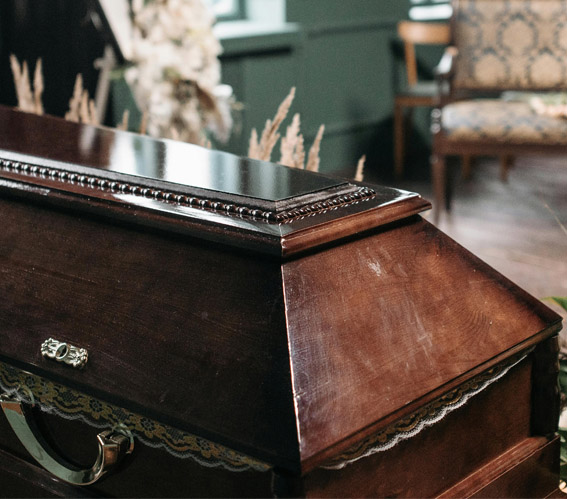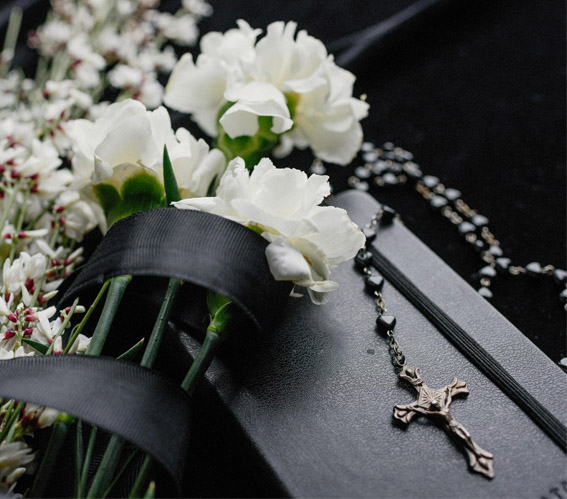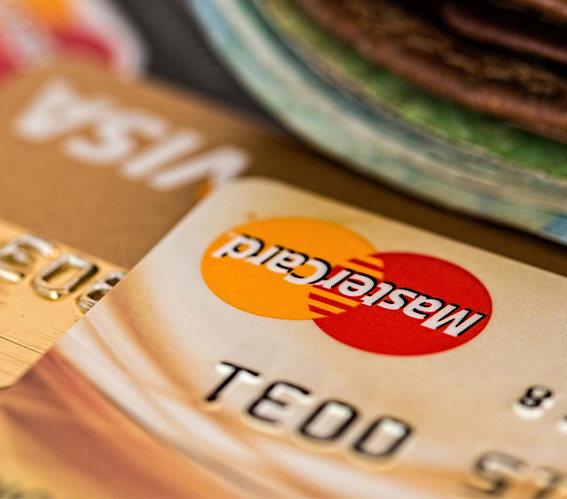Understanding Funeral Costs
How Much Does a Funeral Cost?
In the United States, the median cost for a funeral with viewing and burial is about $7,850. For cremation, most people spend around $6,950. Costs vary significantly by region and city, but that gives you a starting point.
As with weddings or other events, there is a large spread among funeral costs. When getting married, if you go to a courthouse, you can sometimes wed for less than $100. If you have a lavish reception, the bride wears a designer gown, and you include 500 friends and family members, you can easily spend several hundred thousand dollars.

A similar concept applies to end-of-life arrangements. You can have a simple cremation with no hosted reception or celebration-of-life ceremony for less than $1000 in many cases. On the other hand, you can easily spend tens of thousands for a funeral that spares no expense, several large memorial events, and an elaborate grave marker.
Some families choose to have a service with eulogies, music, and other tributes to the deceased without the presence of the remains.
This memorial service can have all the same elements of a traditional funeral with the body present. For many loved ones, it is the intent of honoring the deceased that is important. You don’t need to sacrifice that if you opt for cremation.
If you are pre-planning your own arrangements, rest assured you can be properly remembered, mourned, and celebrated if you choose cremation.
If you choose cremation, you can still have whatever type of service you feel properly honors your loved one and their legacy. Whether that is a traditional funeral with the body present, a memorial service with either cremains or no remains at all, or some other ceremony of remembrance, cremation won’t stand in your way.
There are some basic costs associated with every death. The primary expense in this category is disposal of the remains, generally through burial or cremation. Everything else depends on your choices. Those will drive the budget.
If you want a rough estimate of what you can expect to spend, start with the median funeral costs of about $7,850 for a burial and $6,950 for cremation, knowing that your decisions and details will push those numbers up or down.

What Are the Expenses for a Funeral and Other Arrangements?
What elements make up those $7,850 and $6,950 averages? To better understand where your costs might fall in that range, you should understand common expenses associated with final arrangements. That can help you better estimate the likely costs for the funeral you are planning.
Whether you are making arrangements for a deceased loved one or trying to pre-plan for your own funeral costs, start with this list. Decide which items you want or need to include. Figure out where you want to splurge on something or save on items that don’t feel especially meaningful.
Here are some costs and average expenses. Keep in mind that not all of these are required, nor is this list comprehensive. Also, remember that costs will fluctuate based on your area.
- Basic Service Fees: $2500
- Remains Transfer: $400
- Embalming: $850
- Casket: $1500-$5000 or more
- Printed Material for the Service: $200
- Transfer Vehicle: $175
- Hearse or Similar Car: $375
- Use of Facilities for the Viewing: $475
- Use of Facilities for the Service: $550
- Vault: $1700
- Cremation Fee: $400
- Urn: $300
- Alternative Cremation Remains Container or Arrangement: $150
Your arrangements may include only some of the above items. You may have additional costs such as food or flowers. However, this list gives you a starting point for many potential line items. Your choices will drive the required costs and whether you fall above or below the average expense.
For example, in most cases, you need a casket for the buried remains. You can opt for a simple pine or metal casket or an ornate mahogany version. You’ll also need a cemetery plot and a grave marker. Body disposition may include fees for embalming and cosmetic services if you plan to have an open casket.
The ceremonial aspects drive much of your funeral costs or final expense budgets. You may pay fees for funeral facilities for viewing, an officiant, or a hearse to transport the remains to a graveside service. Will you have printed materials for the attendees, flowers, and a large funeral wreath? Will you rent a space at a funeral home, park, or event facility? Or will you gather with friends to celebrate the deceased’s life and legacy informally? Will it be a hosted event where you provide food and drinks or a potluck where everyone contributes food and shares memories of happy times spent with the deceased?
There’s no single right answer to these questions. You need to decide what options fit your budget and feel most fitting for the person you are trying to honor and remember.
How Can I Pay for a Funeral?
Whether you opt for the most basic body disposition or a no-expense-spared service with multiple memorials, funerals are expensive. Most people or families will struggle to come up with thousands of dollars with little to no notice. It makes sense to start thinking now about how you will cover the final expenses of a loved one. Better yet, consider the costs to your loved ones associated with your eventual passing. Doing so now means your death doesn’t create a financial burden for the people you care about. There are several ways you can plan and pay for funeral costs.
Pre-Planning and Prepaying
When considering your own future arrangements, prepaying is one of the best ways to save money. First, it means the expense is your own rather than something your loved ones must cover.
Second, you lock in today’s prices for a future service. The National Funeral Directors Association reported an 8.1% increase in average funeral costs between 2021 and 2023.
With costs rising that quickly, you can save a tremendous amount by prepaying.

Prepaying also means you have complete control over the details of your funeral and funeral costs. If a luxurious casket is important to you, paying for it now ensures you get it. Perhaps you feel cremation is most appropriate for your legacy. Choosing that now and covering the costs means you know how the disposition of your remains will be handled. You’ll receive exactly what you’d hoped for.
Working with a company specializing in helping people prepay funeral costs ensures that you plan for as many details and eventualities as possible. The more you cover with your plan, the less your loved ones need to figure out or pay for. Coming up with a comprehensive funeral pre-plan is critical to decreasing the financial and emotional burden your death creates for those you leave behind.

Life Insurance Policy
You can also choose to take out a life insurance policy, intending that the payout be used, at least in part, to help cover funeral costs. If your premium is paid and the policy remains active, there will be a payout upon death.
If you want this policy to help with your final expenses, keep in mind that many policies expire, at which point you’ve paid years of premiums and there will never be a payment.
Additional coverage as you age can be prohibitively expensive, meaning you may no longer have a policy in place when you pass away. Also, the beneficiary will receive their payout with no stipulations. If your intent is for the funds to cover funeral costs, ensure you select a beneficiary you can trust. Let them know in advance that you expect them to use the funds for your final arrangements.
Final Expense Insurance
Another option is final expense insurance, sometimes called funeral or burial insurance. Unlike a life insurance policy, final expense insurance only covers funeral costs. Coverage varies based on your policy details, but most will cover the medical, legal, and funeral expenses associated with your death.
Coverage amounts are usually much lower than life insurance, ranging from $5,000 to $25,000. Because the payout is lower, the premiums are lower as well.
The beneficiary of a funeral insurance policy uses the payout at their discretion to cover final expenses. That means they may choose not to cover some items or make different final arrangements than the deceased would have preferred.


Savings Account
Many people assume that their heirs can use money in their savings account to cover their eventual final arrangements. There’s one big problem with this plan: when someone dies, access to their assets and accounts is often frozen while their estate goes through probate.
Probate is the legal process where the court system accepts a will as valid. An approved person–the executor–then determines what assets and debts the deceased had and how those should be handled. During this process, your assets are in limbo. They typically can’t be spent because the court and the executor haven’t yet determined who can spend them.
While this will all be worked out eventually, it could be weeks or even months after someone’s passing before their heirs can access their funds. That means the person’s loved ones must come up with the money for final arrangements.
Many funeral costs need to be paid immediately. They can’t wait six weeks or more until your savings account funds are released. Having a savings account may mean that, eventually, your family is reimbursed for what they spent on final arrangements. But it doesn’t help cover those costs immediately. That could mean your family can’t give you the send-off they feel you deserve because they lack available funds.
POD account
A Payable-on-Death (POD) account is another way to help pay for your final arrangements. During your life, you can use this like any other savings account. However, it has a named beneficiary.
That person has no access to the funds during the owner’s lifetime. Upon the account holder’s death, the funds immediately go to the POD beneficiary.
This transfer means the account avoids probate and is available immediately after the bank sees legal proof of death.

An account payable on death avoids the probate delay with a regular savings account. In most cases, adding a POD beneficiary to an existing account is easy. However, be aware that there is no legal requirement that these funds be used to cover your final expenses.
Choose your beneficiary very carefully. Ensure they understand that your funds should be used for funeral costs. Be mindful that if you spend the funds during your final months or days, perhaps on medical care or other expenses, there will be nothing left for the beneficiary or your final expenses.
How Do I Keep Costs Down?
Don’t succumb to the temptation to choose the most expensive or elaborate options in order to feel like you’re properly honoring your loved one. If the deceased was a simple, modest person, spending more on an elaborate headstone or urn might not feel true to who they were.
Choose to spend more on the categories that make the most sense in the context of the person’s legacy and preferences. If they didn’t care about flowers but were a lifelong music lover, let the funeral choices reflect that. Perhaps the flower arrangements are more modest or non-existent, but you splurge for live music at the memorial.
Even if your loved one prepaid most of their expenses, or there is money set aside for funeral costs, you still don’t want to spend more than necessary to have the service you want. If you are looking for ways to keep costs down, here are some options to get you started:
Talk to Several Funeral Homes
Gather price lists from several vendors. Price may vary significantly between providers. Once you have pricing information from multiple sources, you can compare costs. While the price might not be the only factor in determining which funeral home or other vendors you use, it can help guide your choices.
Some people feel uncomfortable price-shopping for final disposition services. However, it doesn’t mean you loved the deceased any less if you work to ensure you aren’t overpaying for their funeral. Asking for price lists is no different than reaching out to more than one car dealer when purchasing a vehicle or looking at several stores when replacing a household appliance. As with any significant expense, you want to understand what options are available and what you are paying for. You don’t need to feel bad about not wanting to waste money by paying more than necessary for funeral services.
Shop Around for a Casket or Urn
It isn’t just the funeral home for which you should compare prices. A burial container makes up a significant portion of funeral costs. Most casket options are a thousand dollars or more. You can purchase a casket or urn from an outside vendor and provide that for the funeral home to use. You can save hundreds or even thousands of dollars on a comparable casket or urn by looking at sources other than the funeral home.
You can still honor your loved one with a burial container that fits their life and legacy without overpaying. Comparing prices and being willing to bring in a casket or urn from an outside source is a great way to keep funeral costs down.

Opt for Cremation
Unless you or the deceased prefer burial, cremation may be the best choice. It is usually significantly cheaper than burial, with median costs coming in about 10% less. This single choice could save you nearly a thousand dollars on the funeral costs. In many cases, cremation allows you to skip embalming, resulting in even more savings.
Your individual choices will drive how much you save on cremation versus burial, but the differences in cost are significant. If cost is a concern, strongly consider cremation.
Skip Embalming
If your state or locality does not require embalming, forgoing this process will reduce costs. Average embalming services are about $800. You can choose instead to preserve the remains through refrigeration or skip preservation and have an immediate burial or cremation.
Some areas have laws requiring embalming if a body is not cremated or buried in a limited time window. If forgoing embalming is part of your plan, speak with the funeral home or cremation service about any limiting ordinances.


Have the Service at a Private Residence
Whether you do a funeral service before the burial or a memorial service afterward, your choice of venue will play a significant role in determining your funeral costs.
A funeral home will charge you a venue fee. You will also have to pay for their staff. Instead of using their facilities, consider holding the service at a private residence or other location. In addition to saving money, this may feel more meaningful and personal. For services where the remains won’t be present, you could also consider a public park, beach, or other location significant to you or the deceased.
What Happens if I or My Loved Ones Can’t Afford a Funeral?
With funeral costs rising quickly and many people failing to plan for the expense adequately, the grief of losing a loved one can be compounded by a financial shock. For families who have lost someone but don’t have the funds for a funeral or cremation, direct burial or cremation is an option.
Direct burial or cremation is when the deceased is buried or cremated shortly after death. There is no embalming necessary because the body disposition happens almost immediately. Visitation isn’t possible because the remains are disposed of quickly to keep costs down and avoid the expense of preparatory procedures.
Direct burial or cremation does still have costs. Those may include the funeral home’s fee for basic services, body transportation fees, the purchase of a casket or cremains container if needed, a burial plot, a crematory fee, and potentially a funeral home fee if the family has a graveside service.
Direct burial or cremation is usually the cheapest way to dispose of remains legally. It can be thousands of dollars less than a traditional funeral or cremation.
If you opt for direct burial or cremation because you can’t afford other funeral costs, you can choose to have a memorial service at home or at a later date when funds allow.
What Are My Rights Under the Funeral Rule?
The Federal Trade Commission enacted the Funeral Rule in 1984 and amended it in 1994. This rule protects consumers by helping ensure they have sufficient information about the prices of goods and services they purchase from funeral and cremation providers.
Before the Funeral Rule, grieving families had to navigate a confusing system. It was often unclear what their bill included or what options they had. The Funeral Rule protects loved ones, making the system more transparent and decreasing funeral costs. All funeral service providers must comply with the rule.
Here are the protections offered by The Funeral Rule:
- You can obtain price information over the phone without providing personal information.
- Funeral homes must provide an itemized general price list when you visit for information.
- You only need to purchase the funeral arrangements you want. The funeral home can not tack on additional required services or required items.
- You can see a casket price list prior to viewing options.
- Before your purchase, you will receive a written statement that outlines what you are buying. This statement will include the individual cost of each item and a total.
- The provider must give you a written explanation of any legal cemetery or crematory requirements that may require you to buy services or goods. If there are legally required fees that you can not opt out of, this is where you will receive that information.
- You are not required to use embalming on the remains.
- You can use a container other than a casket for cremation.
- You can provide your own urn or casket. The funeral home can not charge an additional fee for bringing your own container. That means you can shop for caskets, urns, or other containers to find the best price and option for your situation.
All these protections prevent hidden fees. They also mean you aren’t pressured to pay a bill that contains surprises at the time of service.
While you are grieving, it can be challenging to advocate for yourself. Pushing back on unfair policies or unclear pricing during an emotional time is difficult. Thanks to the protections provided by the Federal Trade Commission’s Funeral Rule, you have more funeral and cremation services options. The pricing for everything will be clear and readily available. That means you can focus on processing your loss and honoring your loved one rather than trying to understand unclear bills and confusing policies. These protections apply whether you are planning services for someone else or pre-planning your funeral.
What Should I Ask the Funeral Home or Other Vendors?
When planning a funeral for a loved one or pre-planning your own funeral, it makes sense to have a list of questions to ask. If you go in without a plan, you may fail to obtain critical information. Here are some things you may want to ask of potential funeral homes or other vendors:
- What options do they provide for viewing, embalming, cremation, and memorial services? If you know the type of services you want, you only need to ask about those services. For example, if you’ve settled on cremation, you don’t need to ask about burial services. If you don’t like the idea of a graveside service, you can skip those options.
- Request a copy of their general price list. This list will show you the costs of all their goods and services. Make sure you understand which items are required and which are optional.
- Ask them to provide a list of their casket, urn, and other outer burial container prices. This information may be included in their general price list. If it isn’t, ask to see it. Remember that the Funeral Rule requires them to allow you to provide a casket, urn, or outer burial container from an outside source. Many families decide it is easier to use one provided by the funeral home as it is one fewer detail they need to manage. However, understand that if you prefer to shop around or explore other options, you can.
- Inquire about any options for payment. If you are pre-planning your own funeral, they may have payment plans. If you are planning the funeral for a deceased loved one, some funeral homes may still have payment options, though they are likely more limited.
- If your loved one had funeral insurance or you are considering funeral insurance during your funeral pre-planning, ask if the vendor works with insurance companies.
With average expenses nearing $8,000 and rising quickly, it is critical that you understand funeral costs and how you can manage them. Most people plan for life’s joyous occasions, saving money for education, weddings, purchasing homes, and even celebrating birthdays and anniversaries. It’s equally important to plan for final celebrations.
If you want to prevent your loved ones from having to sort all this out on a tight timeline while grieving your passing, pre-planning your funeral transfers the burden away from them. They will be free to focus on honoring your legacy and celebrating cherished memories.
Find a Funeral Home Near You
Planning ahead for your funeral is a simple process. You don't have to wait! Make plans now.
